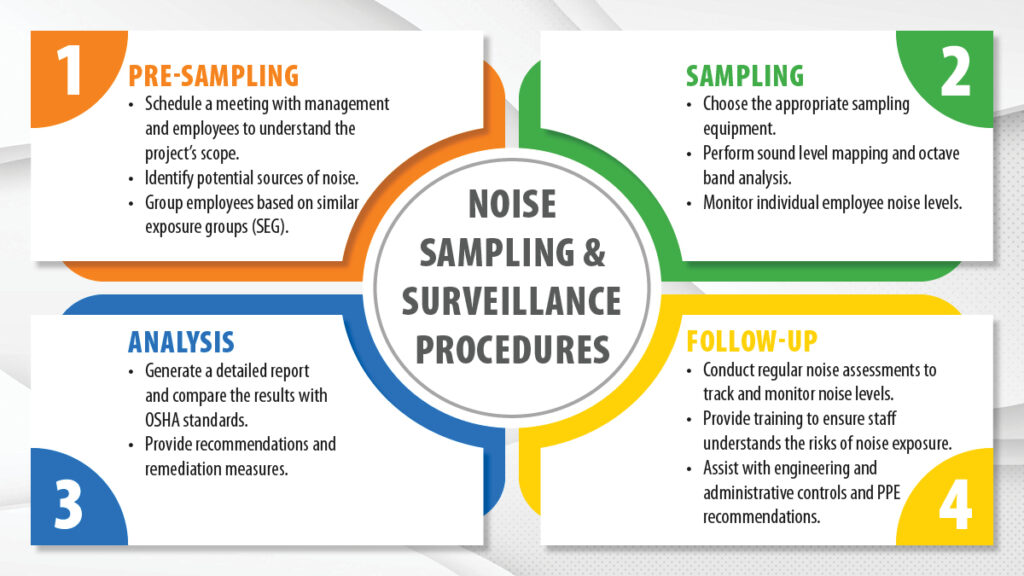October is designated National Protect Your Hearing Month, presenting an excellent opportunity for organizations to evaluate their noise exposure levels and take action to prevent hearing loss in the workplace. Employers are required to quantitatively determine their workers’ noise exposures to ensure they provide a healthy and safe work environment. Gathering data on both area sources and individual noise exposure levels can provide valuable insights into sustained or intermittent loud noise and help establish proper controls to mitigate this hazard. By understanding our workers’ exposures, we can identify and address employee hearing-related risks, such as permanent hearing loss, psychological stress, workplace accidents, and reduced worker productivity and morale.
Managing noise in the workplace can be challenging, but Safety Solutions and Supply is here to help. As part of our industrial hygiene and occupational health services, we offer Noise Sampling and Surveillance Services to help you quantify the risks associated with excessive noise levels. Our team of safety experts can assist employers in developing a compliant and effective hearing conservation program that includes engineering and administrative controls and make recommendations for personal protective equipment (PPE).
Our experts will measure the noise levels in your working environment and provide detailed reports to help your organization comply with regulatory requirements, such as those set forth by the Occupational Safety and Health Administration (OSHA). We work closely with our clients to implement effective noise control measures, providing recommendations that offer achievable and manageable remediation to reduce employee noise exposure. Whether in a construction or industrial environment, we can help you meet OSHA regulations and keep your employees safe.
Methodology
Our approach to noise assessment involves a systematic process that begins with pre-sampling procedures. We prioritize identifying all potential noise sources and group employees based on similar exposure groups (SEG) for accurate sampling. Once this is done, we can determine the appropriate sampling equipment. Our selection includes calibrated sound level meters and noise dosimeters that measure frequency-weighted and time-averaged sound pressure levels, unweighted peaks, and impulse noise levels. Using noise dosimeters is particularly critical as they measure individual noise exposure over time, providing critical information for accurate assessments as required by OSHA regulations.
During sampling procedures, we conduct a sound level mapping or octave band analysis to identify areas, equipment, or processes producing elevated noise levels. This type of analysis allows for a more targeted approach to addressing noise hazards in the workplace. We may also monitor individual employee noise using personal noise dosimeters to measure the time-weighted average (TWA) for noise exposure. Our sound level mapping and noise survey mapping techniques are instrumental in identifying areas with high noise exposure and pinpointing specific equipment or processes that require noise controls.
After collecting the data during the noise sampling process, we analyze the information to determine if the workplace noise levels comply with OSHA standards. If the noise exposure is hazardous, we generate a detailed report that includes an overview of the area, task, and individual exposure levels. The report also comes with recommendations and remediation measures to reduce noise exposure. Additionally, we provide PPE recommendations based on the manufacturer’s noise reduction rating (NRR) for specific applications. The report provides a precise approach to identifying sources of hazardous noise levels and implementing controls to reduce employee exposure.
Once our team completes a comprehensive workplace assessment and reporting, we follow up with various solutions to ensure compliance with noise exposure limits. We provide regular noise sampling to monitor levels and safeguard employees’ well-being. We also offer training to ensure your staff understands the dangers of noise exposure and how to protect themselves. Our services provide a reliable and effective approach to noise assessment that ensures workplace safety and compliance.
OSHA Compliance Requirements for Hazardous Noise
OSHA regulates noise exposure in general industry under 29 Code of Federal Regulations (CFR) 1910.95 and occupational noise in construction work under 29 CFR 1926.52. The permissible exposure level (PEL) for noise is set at 90 decibels A-weighted (dBA) as an 8-hour TWA and an action level (AL) at 85 dBA 8-hour TWA. Exposure to impulsive or impact noise should not exceed 140 dB peak sound pressure level. If an employee’s noise exposure equals or exceeds the AL, they must be included in an HCP designed to protect workers with occupational noise exposure from hearing impairment. The elements of an HCP include:
- Monitoring employee noise exposures
- Implementing feasible engineering, administrative, and work practice controls
- Providing each overexposed employee with individually fitted hearing protection with an adequate NRR
- Training employees on noise hazards and protection measures
- Measuring employee baseline and annual audiometry (measurement of range and sensitivity of an individual’s hearing)
- If identified, implement procedures for preventing further occupational hearing loss by an employee.
- Keeping records such as exposure measurements and audiometric test results
Safety Solutions and Supply is a turnkey resource to ensure your workplace is compliant with 29 CFR 1910.95 or 29 CFR 1926.52 or help to fulfill elements of an HCP, including routine or specific workplace noise monitoring, training, review of records, and PPE recommendations and sourcing.
Conclusion
In conclusion, protecting your workforce’s hearing is critical for their long-term health and well-being. While some workplace noise hazards may not cause immediate harm, they can lead to permanent hearing loss over time. Employers should conduct noise sampling to identify areas with excessive noise and take steps to mitigate it to help comply with legal requirements and create a safer and healthier work environment. Employers can increase productivity, job satisfaction, and overall success by prioritizing noise monitoring. Therefore, noise monitoring is a small investment that can yield significant returns and should be implemented for National Protect Your Hearing Month and every month to ensure a safe workplace for all employees.
Contact our safety experts at 866-537-2262 or visit www.SolutionsInSafety.com to learn more about our safety consulting, training, and products.

